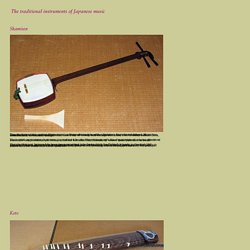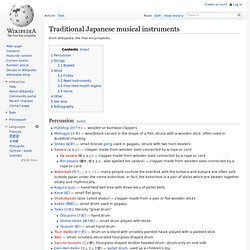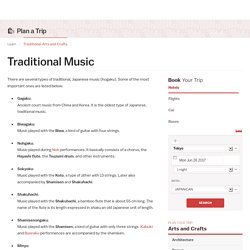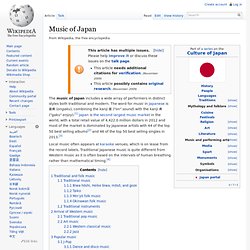

Category:Japanese composers of classical music. Classical Composers Database. The traditional instruments of Japanese music. The shakuhachi is Japan's vertical bamboo flute with five finger holes, four in front and one at the back.

It is an ancient instrument and yet, due to its versatility, it has a uniquely contemporary appeal. Related to similar flutes found in China, India and the Middle East, The shakuhachi was first introduced into Japan around the end of the 7th century AD and evolved through a series of modifiations until it reached its present form during the 17th. century. During the 17-19th centuries, the shakuhachi was played by Zen monks as a form of 'musical Zen meditation'. Called Komusõ (literally, 'Priests of Nothingness'), these men, often ex-samurai warriors, traveled throughout Japan, collecting alms and playing the shakuhachi, their identity hidden behind deep straw hats called tengai. The tengai was symbolic of a wall between the spiritual Buddhist world of the Komusõ and the mundane world of everyday life through which they traveled. Traditional Japanese musical instruments. Percussion[edit] Strings[edit] Bowed[edit] Kokyū - bowed lute with three (or, more rarely, four) strings and a skin-covered body Wind[edit] Flutes[edit] Japanese flutes are called Fue. there are eight different flutes Reed Instruments[edit] Hichiriki (篳篥) — double-reeded instrument used in gagaku Free reed mouth organs[edit] Horns[edit] Horagai (法螺貝) — seashell horn; also called jinkai (陣貝)

Japanese music. Traditional Japanese Music 1. Traditional Japanese Music. There are several types of traditional, Japanese music (hogaku).

Some of the most important ones are listed below: Gagaku: Ancient court music from China and Korea. It is the oldest type of Japanese, traditional music. Biwagaku: Music played with the Biwa, a kind of guitar with four strings. Nohgaku: Music played during Noh performances. Music of Japan. The music of Japan includes a wide array of performers in distinct styles both traditional and modern.

The word for music in Japanese is 音楽 (ongaku), combining the kanji 音 ("on" sound) with the kanji 楽 ("gaku" enjoy).[1] Japan is the second largest music market in the world, with a total retail value of 4,422.0 million dollars in 2012 and most of the market is dominated by Japanese artists with 44 of the top 50 best selling albums[2] and 46 of the top 50 best selling singles in 2013.[3] Local music often appears at karaoke venues, which is on lease from the record labels. Traditional Japanese music is quite different from Western music as it is often based on the intervals of human breathing rather than mathematical timing.[4] Traditional and folk music[edit] Originating as early as the 13th century are honkyoku (本曲 "original pieces"). Traditional music[edit] Biwa hōshi, Heike biwa, mōsō, and goze[edit]